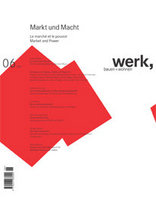Zeitschrift
werk, bauen + wohnen 6-02
Markt und Macht
It is not only the planning process that has to sort out needs and potentials today, architecture has to do this as well. The co-operative development plans that are so popular with politicians and property specialists are a response to growing uncertainties in the context of anonymous investments and location competition. In this game with an increasing number of variables and eventualities there is no „authentic“ concept of use, and no certainty of a stable context - which does not mean that these parameters have worked through to the full. This issue presents various objects in the field of tension of pressure between exploitation and programme instability: rolling planning and architecture production in the rebuilding of an industrial quarter in Baden, a new version of the Unité d'habitation in Amsterdam, a hybrid commercial building in Vienna. What is interesting about these variably programmed structures without typologically fixed qualities is not that a timeless-resistant „building culture“ has been transfigured, but the question of the cultural relevance - and competence - of architecture when helping to shape the urban. The demarcations that usually separate planning and urban development matters from the purely architectural plane are deliberately blurred in this issue. If the production of city and public quality are discussed under current market conditions, the problems involved crystallize in the architectural object: urban development matters tend nowadays to be implemented not so much through long-term guidelines and devices, but through project-related strategies and media-effective interventions. The e-mail interview with various practitioners shows how in Switzerland energies are focussed on investment-relevant locations, urban development scenarios developed and passed on. After the end of universalist planning ideas, this „island urbanism“ accepts that architectural set-pieces both generate and absorb energy. It also results in the magnetism of good architecture being overestimated. From the point of view of planning Andreas Herczog establishes that after a decade of de-regulation it would be high time to confront various trends structurally again, with more comprehensive, political approaches. For problems like functional break-up or the further increase of mobilization and land use cannot be solved by crisis management alone. A critical response to the current trend towards island urbanism can come „from below“, as Philipp Oswalt shows in his contribution on the EU Urban Catalysts research project: since the eighties, sub-cultures (squatters, techno-culture, the gay scene etc.) have structurally transformed the public realm on their own. Within urban residual spaces left over by developers they have set up isolated territories linked to ephemeral uses and events. The protagonists of this „other“ urban quality essentially have a tactical lead, so that in the current age of project related planning processes the questions of meaningful synergies should be investigated. Admittedly Urban Catalysts does not condemn itself to the capital-weak underground: they too are exposed to gentrification, and their achievements to exploitation through branding. The urban is a dynamic setting that has to be constantly reconfigured, renegotiated and reinterpreted.
André Bideau (Translation: Michael Robinson)
André Bideau (Translation: Michael Robinson)
Weiterführende Links:
Verlag Werk AG







